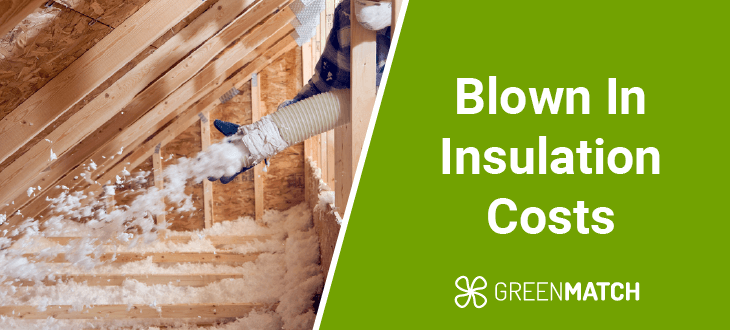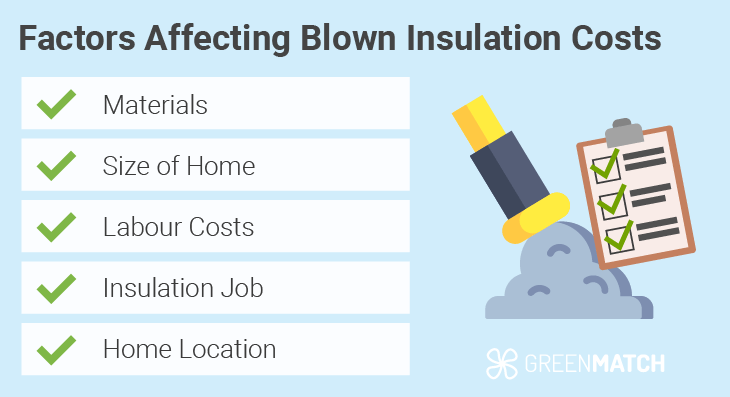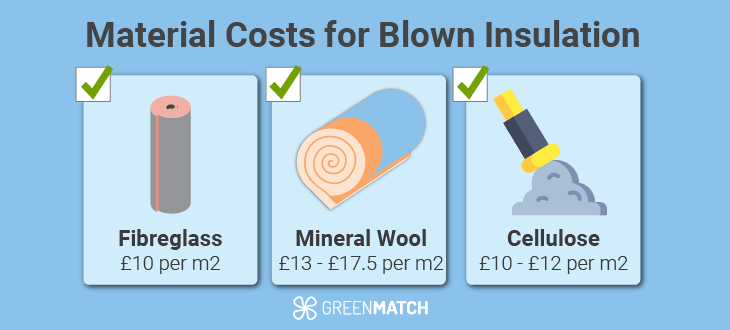Answer these simple questions and we will find you the BEST prices
Which type of solar quotes do you need?
It only takes 30 seconds
100% free with no obligation

Get Free quotes from insulation specialists near you

Save money by comparing quotes and choosing the most competitive offer

The service is 100% free and with no obligation
- GreenMatch
- Insulation
- Blown In Insulation
- Blown Insulation Cost
How Much Does Blown in Insulation Cost?


- Loose fill insulation material costs per m2 usually range around £10 - £18 depending on your chosen material.
- Fibreglass, mineral wool, and cellulose are the most popular blown-in insulation materials.
- Blown loft insulation can save a detached home up to £340 in annual energy bills.
Blown-in insulation is a handy style of applying home insulation that is quick, affordable and effective. It involves an installer spraying loose-fill insulation material into a space using a special applicator hose.
It’s a thermal upgrade that works particularly well for lofts, suspended timber floors, cavity walls, and internal stud walls. Blown-in insulation improves your home's thermal efficiency, helps you save on energy bills, reduces your domestic carbon footprint, and regulates your home's temperature, all with a single investment!
This guide by GreenMatch UK will walk you through blown insulation costs, the cheapest options, insulation grants, and much more.
Ready to insulate your home? Look no further than GreenMatch UK for all your needs. Instead of spending countless hours researching and vetting installers, just spend 30 seconds filling out our online form and receive up to 3 free home-tailored quotes from professionals. No charges, no obligations. Simply click below to begin!
Fill in the form in just 1 minute
What is the cost of blown in insulation?

The average cost of blown in insulation for your home will hinge on several factors, such as your budget, choice of material, existing insulation, and home type.
In general, loft insulation will cost around £950, cavity wall insulation around £2,700, and solid (stud) wall insulation around £7,500 for a typical 3-bedroom semi-detached house in the UK.
In general, these are the factors that will influence your overall costs:
- Materials: Depending on the type of loose-fill insulation you opt for, you can expect to spend around £10 - £18 per m2 of material. By comparing this to the m2 measurement of the area that needs insulating, you can get a good idea of your material costs.
- Size of home: The size, type and style of home you have can very well impact the price of an insulation job. There are several types of homes in the UK, with semi-detached homes and apartments being the most popular.
- Labour costs: Luckily, blown insulation is a relatively quick process taking no more than 1 -2 hours in most cases. As such, labour costs are expected to be around £50 - £100.
- Insulation job: Cavity wall insulation requires the use of scaffolding and professional industry equipment which may add to costs, whereas loft insulation can be as simple as blowing the insulation through an open window.
- Home location: Generally, cities cost more than rural areas, and narrow urban city streets may cost more due to accessibility and neighbourhood disruptions.
It may be true that a DIY blown in insulation cost may be cheaper in the short term, but a shabby job and poor workmanship can lead to years of mounting repair costs. Therefore it's highly recommended to carry out home upgrades with professional installers.
Blown in insulation cost per material type

Blown-in insulation is carried out by spraying loose-fill insulation into a space using special applicator equipment. There are three main materials used for this purpose; fibreglass, cellulose, and mineral wool.
Each material has its perks, for example, blown in fibreglass tends to be the cheapest, blown in cellulose insulation tends to be the most sustainable, and blown in mineral wool tends to be the best cost-to-performance ratio.
Here’s a breakdown of what you could expect to pay per m2 of each material:
| Material | Cost per m2 |
|---|---|
| Fibreglass | £10 |
| Cellulose | £10 - £12 |
| Mineral wool | £13 - £17.5 |
Calculating an accurate blown insulation cost for home types is difficult to do without more information about your specific home, the area to be insulated, existing insulation measures, and much more. Therefore, a house inspection needs to be conducted.
Professional installers often tend to offer free housing assessments to determine the scope and cost of a job tailored to your home. By working with a professional and accredited installer, you can get the best idea of what to expect, and whether it suits your budget.
What is the cheapest blown insulation?
Based on material costs alone, fibreglass tends to be the most budget-friendly loose-fill insulation material on the market. Despite its lower cost, it certainly does not fall short on thermal performance and properties.
Fibreglass is a fire and moisture-resistant material made from recycled glass. It comes as fibrous clumps when purchased as loose fill (ideal for blown-in insulation), but can also be found as blankets, sheets and batts of material.
Insulation grants
If the costs of a blown-in insulation job seem daunting to you, not all hope is lost. In line with the UK’s ambitious Net Zero by 2050 goals, the government has rolled out two key home insulation grants that help low-income and fuel-poor households with free insulation coverage.
These two schemes are the Great British Insulation Scheme (GBIS) and the Energy Company Obligation (ECO4). Both schemes are active until March 2026, and provide qualifying households with free or reduced-cost insulation coverage depending on the qualification criteria you meet.
To apply for the GBIS scheme, visit the official UK government portal to learn more and fill out the application form. For the ECO4 scheme, contact your energy provider directly to learn more about the application process.
Cost of insulating attic with blown insulation
The average blown in attic insulation cost in a standard UK semi-detached home is around £950. This price can fluctuate depending on the type of home you have, and several other important factors.
Here’s our breakdown of the average roof and loft insulation costs, savings, and break-even periods that you can expect to face:
| Home type | Average cost (£) | Annual energy bill savings (£/year) | Payback period |
|---|---|---|---|
| Mid terrace home | £900 | £180 | 5 years |
| Semi-detached home | £950 | £200 | 4 - 5 years |
| Detached home | £1,200 | £340 | 3 - 4 years |
| Detached bungalow | £1,200 | £330 | 3 - 4 years |
As you can see, loft insulation boasts some of the quickest payback periods of any home insulation upgrade, almost always within 5 years. This, combined with budget-friendly blown-in insulation, is an investment that brings your home massive savings and decades of comfort.
Cost of insulating walls with blown insulation
The cost of blown in insulation in walls depends on the type of walls you have; solid walls or cavity walls. Solid walls are common with pre-1920 homes and consist of a single brick layer wall, whereas cavity walls are more common post-1920, and are made up of an inner and outer wall with a cavity space in between.
Solid walls can be insulated only internally if you’re planning to do blown insulation. This is when stud walls are built on the inside of your home, which can be filled with loose-fill insulation. This process costs around £7,500 for a typical semi-detached house in the UK.
As for blown cavity insulation, prices can fluctuate depending on the type of home you have. Here’s our breakdown of blown cavity wall insulation costs per m2, annual savings, and payback periods for blown cavity wall insulation per house type:
| Home type | Average cost (£) | Annual energy bill savings (£/year) | Payback period |
|---|---|---|---|
| Mid floor apartment | £1,000 | £100 | 10 years |
| Mid terrace home | £1,500 | £130 | 11 - 12 years |
| Semi-detached home | £2,700 | £210 | 12 - 13 years |
| Detached home | £4,600 | £370 | 12 - 13 years |
| Detached bungalow | £2,100 | £160 | 13 - 14 years |
It's good to keep in mind that the most accurate way to know your expected costs is to conduct a professional home assessment with an installer. That way, a retrofitting assessment can determine your specific needs and what it may cost you.
Obtain multiple quotes to get the best deal on blown insulation
While insulating your home is a great step, a professional accredited installer can be the difference between decades of home comfort, and endless repair costs of a shabby installation.
Therefore, researching and vetting potential installer options is an important step. By comparing multiple quotes from various installers, you can even land yourself a great bargain.
However, the sea of installers out there can get overwhelming and take endless hours of web searches and phone calls to conduct. Most of us don’t have this kind of time, but luckily here at GreenMatch, great deals with professional installers are just a button click away.
By filling in our quick 30-second survey, you can secure up to 3 free home-tailored quotes from our nationwide network of trusted professionals. The best part? Our services are completely free of charges and obligations. Simply click the button below to begin!
Fill in the form in just 1 minute
FAQ
Blown insulation is worth the investment if installed correctly by a professional installer. It can bring your home decades of thermal comfort at a lower price bracket than most other synthetic insulation materials.
The average cost of blown loft insulation for a typical UK semi-detached home is around £930. This price can fluctuate depending on your chosen material, home size, and loft conditions.
The cheapest blown in insulation material is fibreglass insulation, at around £10 per m2. This is closely followed by cellulose insulation which can also range from around £10 – £12 per m2.
The cost of blown cavity wall insulation per m2 is difficult to calculate, as many factors hinge on this cost. Factors such as your chosen material, home type, additional repairs, location and much more play a role in your cost. Nevertheless, a standard semi-detached home can expect to pay around £2,700 for cavity wall insulation.
The price to insulate the loft of a 3-bed house is around £930, cavity wall insulation around £2,700, and internal (stud) wall insulation around £7,500.

Akif is a copywriter at GreenMatch since 2023. With a keen interest in community sustainability, green solutions and the role of digital media in identifying climate trends, he aims to hone in on his background in International Studies and Digital Media to provide a multidisciplinary approach to written content rooted in credible research and accuracy.
We strive to connect our customers with the right product and supplier. Would you like to be part of GreenMatch?

